Understanding Pet Bird Regurgitation: Causes & Care
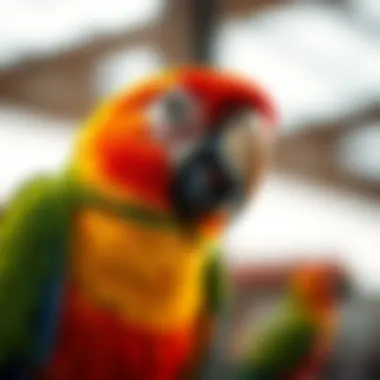
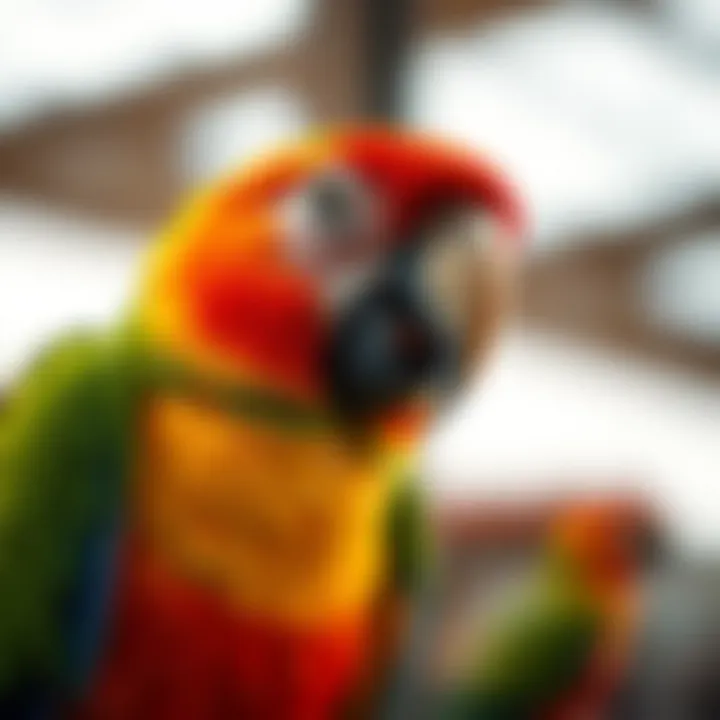
Intro
Birds are remarkable companions that bring joy and vibrancy into our lives. However, understanding their behaviors, especially the less straightforward ones, can be tricky for many pet owners. One such behavior is regurgitation, a natural but often confusing phenomenon in the avian world. For bird owners, recognizing the reasons behind this behavior can significantly enhance the bond with their feathered friends. This article dives into pet bird regurgitation, shedding light on its causes and what it means for the health and wellbeing of your bird. With valuable insights, practical tips, and a dash of curiosity, we aim to empower bird lovers in interpreting and managing this intriguing aspect of avian behavior.
Avian Care Basics
Caring for a pet bird involves more than just providing a cage and food; it’s about understanding their needs, ensuring a supportive environment, and fostering a healthy, happy lifestyle.
Importance of Proper Nutrition
A balanced diet is essential for a bird's health. Just like how a well-fed human functions better, birds thrive when their nutritional requirements are met. Offering a variety of seeds, pellets, fresh vegetables, and fruits can significantly aid in digestion and overall health.
Understanding Bird Species and Their Needs
Not all birds are created equal; every species brings its unique set of requirements. For instance, feeding a parakeet the same diet as a macaw wouldn't cut it. Each species exhibits distinct behaviors and dietary needs worth considering. Researching and understanding your bird’s specific requirements is key.
Basics of Birds Habitat Setup
Creating a suitable habitat is fundamental for avian welfare. The cage should be appropriately sized and located in a bustling part of the home—not too close to drafts or direct sunlight. Use materials that are safe, and ensure perches, toys, and activities are tailored to your bird's size and preferences.
Grooming and Hygiene Tips
Regular grooming helps maintain a bird’s health and destresses them. A weekly inspection, trimming of beaks and nails, and the occasional bath can keep your pet feeling fresh and looking spiffy. Negligence here could lead to serious problems for your feathery friend.
Interacting with Your Pet Bird
Building a connection with a bird can lead to a more rewarding companionship. It allows for better communication and understanding between you and your pet.
Building Trust and Connection
Patience is the name of the game. Birds, especially those who are newly adopted or have had negative exposure to humans, can be skittish. Spending time nearby without forcing interactions can help your bird recognize you as a trusted presence.
Training Techniques and Tips
Training can be a fun way to engage with your bird while reinforcing positive behaviors. Techniques like clicker training can be useful, as they provide clear communication. Gradually introduce tasks, rewarding positive reactions with treats to encourage learning.
Fun Activities for Bird Owners and Their Birds
Interactive play not only strengthens bonds but also keeps your bird's brain active. Offering toys that promote problem-solving or organizing simple obstacle courses can lead to joyful experiences.
Recognizing Bird Cues and Behaviors
Observing your bird helps in identifying its needs and moods. If your parrot fluffs up its feathers, it might be trying to convey comfort or happiness; conversely, if it suddenly avoids interaction, it could mean stress or discomfort. Taking the time to understand these cues can prevent problems down the line.
Emotional Well-Being of Birds
Birds are sentient creatures needing emotional engagement. A neglected bird can develop behavioral issues, so it’s wise to prioritize its emotional well-being.
The Role of Play and Socialization
Social creatures by nature, birds benefit from regular social interactions. Whether through playtime or simply talking, your engagement is critical for their mental health.
Enhancing Birds' Emotional Health
Setting up playdates with other friendly birds can be wonderful for their socialization. Providing a rich environment filled with toys and challenges stimulates their minds and promotes happiness.
Assessing Bird Stress and Remedies
Behavior like excessive screaming or feather plucking often indicates stress. Identifying triggers—be it loud noises or environmental changes—can help mitigate these issues and create a peaceful habitat for your bird.
Building Strong Human-Bird Bonds
The bond you have with your bird can be incredibly fulfilling. Investing time into understanding and nurturing this relationship enhances both your quality of life and your bird’s.
Bird Health and Safety
Maintaining a bird's health involves both daily care and a keen eye for red flags.
Common Health Issues and Prevention
Birds can suffer from a range of ailments like respiratory issues or digestive problems. Staying aware of common disorders can aid prevention. Always ensure the diet and environment facilitate health.
Routine Veterinary Care
Taking your bird to an avian veterinarian prevents potential health issues from escalating. While some might think it’s unnecessary, periodic check-ups catch concerns early on, ensuring a long, healthy life for your pet.
Environmental Hazards to Avoid
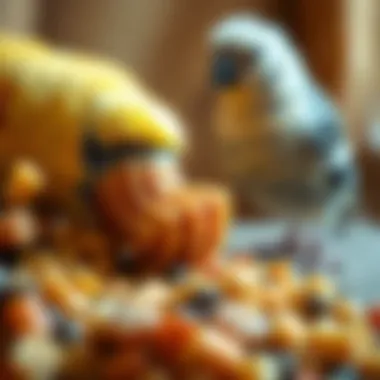

Birds are more susceptible to environmental dangers than many realize. Items such as scented candles, aerosols, and non-stick cookware pose serious threats. Educating yourself on these hazards can take your care game to the next level.
Signs of Illness or Distress
Look for changes in behavior or appearance. If your bird is more lethargic than usual, not eating, or showing unusual feather loss, these are telltale signs that something isn’t right and warrants a veterinary visit.
Fun Facts and Quirky Insights
Unique Traits of Popular Bird Species
Some birds, like cockatiels, are known for their affectionate nature, while African Grey parrots are celebrated for their intelligence and ability to mimic human speech. Understanding these traits not only helps in nurturing your pet but adds layers to your appreciation of avians.
Historical and Cultural Significance of Birds
Birds have been integrated into human culture for millennia. From ancient Egyptian hieroglyphs to modern-day literature, their presence symbolizes freedom and companionship.
Famous Bird Owners and Their Stories
You would be surprised to know that famous figures like artist Frida Kahlo and actor Johnny Depp had their avian companions. Their stories illustrate the profound bonds people often forge with their birds, transcending the mere pet-owner relationship.
Ultimately, understanding regurgitation in birds is part of a larger puzzle—one that paints a rich picture of what it means to care for these beautiful creatures. By embracing the knowledge presented here, bird owners can enhance their interactions, ensuring a lasting bond of trust and love.
For more information on caring for pet birds, consider checking out resources like Wikipedia, Veterinary Partner, and BirdTalk.
Embrace the journey of understanding your feathered friend, and watch your companionship soar!
Preamble to Regurgitation in Pet Birds
Understanding why pet birds regurgitate is pivotal for any bird owner. This behavior often puzzles many, who might mistake it for sickness or inappropriate conduct. However, regurgitation can be a natural phenomenon stemming from various causes, some of which are instinctual and beneficial for bird relationships. By grasping the nuances surrounding this behavior, pet owners can improve their interactions with their avian companions, ensuring they respond with appropriate care instead of concern.
A deep dive into regurgitation can unfold layers of insight into avian biology and behavior, paving the way for a better understanding of what it means when a bird regurgitates. Not only does this enhance the human-bird bond, but it also aids in overall care practices that keep birds healthy and happy.
Defining Regurgitation
Regurgitation is essentially the act of bringing up undigested food from the crop, a pouch-like organ where birds store food temporarily before digesting it. Unlike vomiting, which often involves expelling material from deeper in the digestive tract and is typically associated with distress, regurgitation appears more volitional. Birds may regurgitate for various reasons, both instinctual and learned. For instance, many birds regurgitate as a part of courtship rituals or as a means of feeding their young.
This behavior can also be indicative of bonding among birds and between birds and their human owners.
Historical Perspective on Regurgitation Behavior
Historically, regurgitation has been viewed differently across cultures. For some, it is seen as an essential part of avian social dynamics; for others, it might evoke concern regarding health issues. In the avicultural world, points of view have evolved significantly over the years. Previously, many bird owners solely associated regurgitation with illness or dietary problems. However, as avian understanding has matured, experts now recognize that this behavior can serve multiple functions.
Bird watchers and breeders have long observed regurgitation during breeding seasons, often believing that this act is critical for nurturing the chicks. In practice, the behavior is contextual, depending on the species and its social setting. Literature on bird behavior, such as findings published in ornithological studies, reinforce that regurgitation is a typical part of life for many pet birds and not necessarily a cause for alarm.
By shedding light on regurgitation's roots, we facilitate a more nuanced approach to avian health and sociology. This understanding can help to clarify misconceptions pet owners may hold, steering them towards informed and compassionate routines that enhance their bond with their feathered friends.
"Understanding regurgitation transforms it from a mystery into a bridge connecting owner and pet."
As we journey through this article, we will explore the physiological aspects of avian digestion, the underlying causes of regurgitation, and the various interpretations of this behavior all while ensuring that we provide practical insights for pet bird owners.
Physiology of Avian Digestion
Understanding the physiology of avian digestion is crucial for pet bird owners seeking to interpret regurgitation behavior accurately. Birds possess a unique digestive system that has evolved to meet their specific dietary needs. Unlike mammals, birds do not have teeth to grind food; instead, they rely on a specialized system that allows for efficient processing and absorption of nutrients.
Bird Anatomy Related to Digestion
Birds, from tiny budgies to large macaws, share a distinct digestive anatomy that is fascinating. Key components include the beak, esophagus, crop, stomach (proventriculus and gizzard), intestines, and cloaca. Here’s a closer look at these parts:
- Beak: The beak's shape and size vary among species, influencing how birds eat. For instance, finches have stout, conical beaks to crack seeds, while nectarivorous birds have elongated beaks for reaching into flowers.
- Esophagus: After the beak, food travels down the esophagus, a muscular tube that connects to the crop.
- Crop: This is a vital storage pouch. It allows birds to eat quickly and digest food at their leisure. Birds can regurgitate food from the crop to feed their young, which is crucial for parental care.
- Proventriculus and Gizzard: These two stomach compartments work together. The proventriculus secretes digestive enzymes, while the gizzard grinds food, often using small stones that birds ingest.
- Intestines: Nutrient absorption occurs here. The length of the intestines can vary depending on dietary needs; for example, herbivorous birds typically have longer intestines than carnivorous ones.
This specialized anatomy plays a significant role in how birds process their food and reflects their evolutionary adaptations to various diets. Understanding these components allows bird owners to better interpret their pet's regurgitation and overall digestive health.
The Role of the Crop
The crop functions as a temporary food storage site, which can be surprising to pet bird owners. This storage mechanism allows birds to consume large quantities of food quickly, facilitating the regurgitative feeding behavior observed in many species. Here’s why the crop is essential:
- Feeding Young: The crop is especially important in species where parents regurgitate food for their chicks. This act is not only about nutrition but also promotes bonding.
- Nutrient Processing: The crop doesn't digest food but allows birds to mix it with saliva before it moves on to the stomach. This preliminary step helps initiate the digestive process.
- Signs of Health: A visibly full crop can indicate adequate feeding, while an empty crop may signal illness or stress. Conversely, excess or abnormal regurgitation can hint at digestive issues.
In summary, the crop serves multiple functions vital for pet bird health and behavior. It can also signal changes in health and feeding habits that owners should be attentive to. Understanding these physiological details can enrich owners' insights into their bird's behavior, paving the way for informed care.
Causes of Regurgitation
Understanding the causes of regurgitation in pet birds is vital for several reasons. Contextualizing this behavior helps owners differentiate between normal avian actions and potential health concerns. Knowing what motivates regurgitation can offer insights into a bird's emotional state, dietary habits, and overall health. This section serves to illuminate the multifaceted aspects of regurgitation, which often perplex even seasoned bird owners.
Natural Behavioral Causes
Birds are remarkable creatures, often exhibiting behaviors that can seem odd to us. Regurgitation is, in many cases, a natural part of a bird's behavior. It's not uncommon for birds, especially parrots, to regurgitate for various reasons that are completely normal and instinctual.
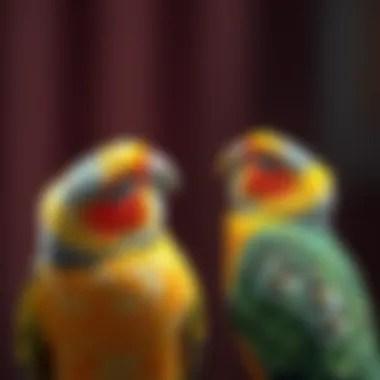
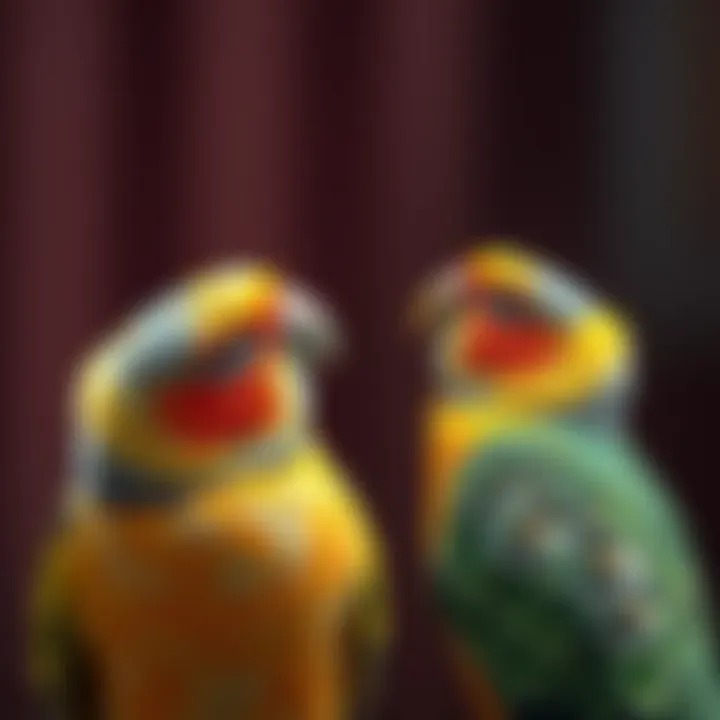
For instance, during courtship, a bird may regurgitate to demonstrate affection or to feed its mate. This is akin to lovebirds sharing a meal, solidifying their bond. Such behavior stems from social instincts deeply engrained in their DNA. Watching a bird perform this action can be mesmerizing, as one might observe the delicate gestures tied to their ritual.
Here are some examples of natural causes of regurgitation:
- Courtship Feeding: As mentioned, regurgitating for a mate is a mark of affection.
- Parental Care: Young birds often rely on their parents for food through regurgitation, teaching them important survival skills.
- Stress Response: Birds can regurgitate when experiencing initial stress or discomfort in new environments.
Dietary Influences on Regurgitation
Diet plays a quintessential role in the health of pet birds and can directly impact regurgitation behaviors. If a bird consumes an unbalanced or inappropriate diet, it may regurgitate more frequently. This reaction can stem from various dietary factors that affect the bird's digestion and overall system.
Many pet birds thrive on a mix of seeds, fruits, and pellets, but their dietary needs can differ significantly based on species. For example, parakeets may need different nutrients from cockatoos. Common dietary influences include:
- High Fat Content: Birds munching on seeds high in fat may become overwhelmed, leading to regurgitation as their bodies attempt to expel excess.
- Spoiled Food: Just like us, birds can get sick from eating spoiled food, which can trigger regurgitation as a defensive measure.
- New Diets: Introducing new foods without gradually acclimating your bird can result in digestive upset, prompting regurgitation.
Health-Related Causes
While regurgitation can be a normal behavior for many birds, it can sometimes indicate underlying health issues that warrant attention. Identifying these health-related causes as early as possible can be a game changer in preventing more serious conditions down the line. Some health issues that can lead to abnormal regurgitation include:
- Gastrointestinal Disorders: Issues such as malabsorption or infections can lead to regurgitation that isn't typical for the bird.
- Respiratory Illnesses: Sometimes, respiratory problems manifest as regurgitation since a bird's throat and crop are closely linked with the respiratory tract.
- Toxins: Exposure to certain poisons, such as heavy metals, can cause gastrointestinal distress resulting in regurgitation.
In summary, recognizing whether regurgitation is driven by natural behavior or is a symptom of potential health issues is key for pet bird owners. If regurgitation persists or is accompanied by other concerning signs, such as lethargy or changes in appetite, consulting with an avian veterinarian is recommended.
"The first step in avian health care is understanding the uniqueness of your bird's behaviors, including regurgitation. This helps foster a thoughtful approach to bird companionship."
By staying proactive and informed, bird owners can help ensure that their feathered friends remain healthy and happy.
Behavioral Implications of Regurgitation
Understanding the behavioral implications of regurgitation in pet birds is crucial for pet owners. It sheds light on not just the health and emotional well-being of these creatures, but also helps deepen the bond between birds and their human companions. By recognizing the subtleties of regurgitation, owners can tailor their responses to enhance their pet's life and provide the right environment.
Normal vs. Abnormal Regurgitation
Normal regurgitation in pet birds often appears as a natural, instinctive behavior. For instance, birds may regurgitate food as a way to share with their mates or chicks. This behavior is commonly observed in species such as cockatiels and lovebirds. Typically, these episodes are brief and often accompanied by soft cooing sounds or body language that clearly shows comfort and understanding. Observing these displays helps owners identify when regurgitation is simply a part of bonding dynamics.
However, abnormal regurgitation raises red flags. This might occur frequently, be accompanied by distressing signs such as feathers ruffled or changes in vocalizations, or happen outside of feeding times. Unusual regurgitation can signal health issues like infections or digestive disturbances. Monitoring these patterns is key to distinguishing between what is normal and what needs attention.
**“Birds communicate through their behaviors – regurgitation is a message that can mean many things.
Misunderstandings About Regurgitation
Regurgitation in pet birds is a topic that can easily lead to confusion and misconceptions. Understanding these misunderstandings is crucial because it helps bird owners better interpret their pets' behavior and take appropriate steps for their well-being. The importance of clarifying this subject hinges on fostering a deeper bond between birds and their owners and avoiding unnecessary health scares.
Common Myths and Facts
It's no secret that misinformation can spread faster than wildfire. Let's take a closer look at some common myths about regurgitation:
- Myth 1: Regurgitation is always a sign of sickness.
- Myth 2: Only certain species regurgitate.
- Myth 3: Regurgitation is always problematic.
- Fact: While it can indicate health issues, regurgitation often stems from normal behaviors, such as courtship or feeding. Birds are complex beings, and their actions can have multiple interpretations.
- Fact: Many birds from cockatiels to lovebirds engage in regurgitation. It’s not exclusive to one type; rather, it�’s part of their natural behavior.
- Fact: Many birds regurgitate as a bonding mechanism. They might do it as a way to show affection or to feed their partners—meaning it can be a healthy expression of their instincts.
Debunking these myths opens the door for owners to appreciate their birds' natural behaviors without jumping to conclusions. They can observe with a more informed mindset, resulting in a healthier relationship with their feathered companions.
Cultural Perspectives on Regurgitation
Avian regurgitation can also be viewed through the lens of cultural perspectives. In various cultures, the act of regurgitation has received differing interpretations:
- Symbolism of Sharing: In many cultures, sharing food is a sign of love and care. Birds often regurgitate to their mates, which mirrors human gestures of sharing meals as a form of intimacy.
- Folk Beliefs: In some parts of the world, animal behaviors are steeped in folklore. Regurgitation might be seen as a ritual, a sign of good luck, or an act of nurturing in some communities.
- Education on Bird Care: The understanding of regurgitation varies globally. In certain cultures where birds are more common as pets, there may be a clearer awareness of normal behaviors compared to regions where these pets are less prevalent.
Understanding all these varying perspectives shapes how pet owners view their birds. It fosters empathy and provides different angles to consider when witnessing regurgitation.
Health Considerations Regarding Regurgitation
Regurgitation in pet birds might seem like a common behavioral quirk, but it carries significant weight when it comes to avian health. Understanding the health implications of regurgitation can make a world of difference for both the bird and its owner. Recognizing what is normal versus what might indicate underlying health concerns is paramount. By delving into this aspect, bird owners can foster a healthier environment and an improved quality of life for their feathered companions.
Regurgitation and Digestive Disorders
The digestive system of birds is uniquely constructed, making it susceptible to various disorders that could manifest as regurgitation. After all, their anatomy isn’t just like ours—it's specialized for a diet that is often high in seeds, fruits, and occasional insects. When the digestive process is compromised, regurgitation may serve as a sign that something isn’t right.
In birds, common digestive disorders include pica, which may lead them to regurgitate indigestible items they have eaten, and candidiasis, a fungal infection that affects their gut. Additionally, gastroenteritis can cause inflammation of the stomach and intestines, leading to frequent regurgitation. Symptoms associated with these conditions can include:
- Lack of appetite
- Abnormal droppings
- Lethargy
Birds that routinely regurgitate should not be dismissed as merely “acting strange.” It’s essential to monitor their behavior closely. If regurgitation appears frequent or accompanied by any of the symptoms listed above, it deserves immediate attention.


Understanding the digestive processes and potential disorders can help caretakers differentiate between harmless behaviors and serious health issues.
When to Consult an Avian Veterinarian
Consulting an avian veterinarian should not be reserved only for severe circumstances. Observations of regurgitation need careful interpretation. Many owners might wonder if they should wait it out or seek professional advice. If a bird’s regurgitation is accompanied by other troubling signs, such as:
- Persistent vomiting
- Weight loss or gain
- Change in behavior (e.g., increased aggression or withdrawal)
- Foul smell from the bird’s mouth
It’s likely time to reach out for expert help. Avian vets specialize in birds' unique needs and can provide a diagnosis through thorough examination, which may involve fecal tests, blood work, or imaging.
The repercussions of ignoring regurgitation—or worse, misinterpreting it—can lead to health crises down the line. Regular check-ups and proactive engagement with an avian vet can also aid in preventive care, ensuring that pets stay on a healthy track.
In summary, understanding health considerations regarding regurgitation is key to every bird owner’s responsibility. By discerning the signals our birds send, we can act as vigilant caretakers, ensuring their overall well-being.
Managing Regurgitation in Pet Birds
Understanding how to manage regurgitation in pet birds is critical for any bird owner dedicated to the well-being of their feathered companion. Regurgitation is often perceived with concern, but it's worth noting that this behavior can play a significant role in avian social behavior and health. Thus, effective management can lead to enhanced bonding and healthier conditions for the bird. Here, we will explore several practical strategies, dietary adjustments, and ways to create a nurturing environment to support birds and their owners through this natural, yet complex behavior.
Strategies for Owners
When dealing with regurgitation, it's essential for pet owners to recognize both the normal and abnormal expressions of this behavior. Some strategies include:
- Observation: Keep a close eye on when and how frequently your bird regurgitates. Understanding triggers can inform your approach to management.
- Routine: Establishing a daily routine gives birds a sense of security. This can help minimize stress, which might reduce unwanted regurgitation.
- Bonding Activities: Spend quality time with your pet through gentle handling or encouraging play. This helps to reinforce trust and could minimize any anxiety that triggers regurgitation.
"For birds, comfort often translates to stability. Fewer surprises mean more security."
Adjusting Dietary Practices
Diet plays an undeniable role in regurgitation. What your bird consumes can influence digestive health and behavioral responses. Consider the following dietary management practices:
- Balanced Diet: Ensure that your pet bird's diet is rich in variety—seed mixes, fresh fruits, veggies, and specialized pellets can meet nutritional needs while reducing the likelihood of digestive upset.
- Limit Overfeeding: Birds may regurgitate due to excess food in their culums. Portion control is vital—feed appropriate servings based on your species’ dietary needs.
- Safe Foods: Avoid foods that may cause digestive troubles, such as avocado or chocolate. Stick to vet-approved safe options for treats.
Creating a Comfortable Environment
The environment in which your pet bird lives can significantly impact its stress levels, thus influencing regurgitation behavior. Here’s how to foster a comfortable space:
- Cage Setup: Provide a spacious and secure cage with plenty of perches and hiding spots. This helps the bird feel secure and less exposed to possible stressors.
- Noise Control: Minimize loud noises and sudden movements, as these can frighten birds and trigger regurgitation. Calm surroundings promote relaxation.
- Social Interaction: Provide opportunities for friendly social exchanges, whether with the family or another bird, as social interactions are vital for their emotional health.
The Role of Social Interaction
The concept of social interaction in avian life cannot be underestimated. Just like us, pet birds are social creatures, and their interactions are vital for their mental and emotional well-being. Understanding how social dynamics play out can illuminate why certain behaviors, like regurgitation, might occur. The interplay between individual birds and their relationships is not only fascinating but also serves as crucial information for pet owners looking to nurture a harmonious environment.
Social Dynamics in Aviaries
In aviaries, where birds of various species coexist, social dynamics often resemble those of human social groups. Birds establish hierarchies, friendships, and sometimes rivalries, which influence their overall behavior. For example, when a new bird is introduced to an existing flock, the existing members may exhibit territorial or defensive behaviors as they re-establish their social order. This can lead to stress, triggering behaviors such as plucking or, in some cases, regurgitation, which can be viewed as a form of distress or an attempt to bond by showing trust.
Moreover, social interactions aren't just about establishing dominance or relationships; they can also involve communication with body language and vocalizations. Birds use specific sounds or movements to express needs and emotions, which deepens their social ties. Watching these interactions can enhance an owner’s understanding of their bird's personality and well-being.
Here are some elements to consider about social dynamics in aviaries:
- Dominance Hierarchies: Understanding how birds rank within the group can indicate stress levels.
- Bonding Behaviors: Look for signs like preening, which demonstrate trust and affection.
- Communication Styles: Observe vocalizations that serve as a means of expressing feelings or warnings.
Regurgitation in Pair-bonded Birds
Regurgitation among pair-bonded birds often signals a profound social connection. Birds, especially species like cockatiels or budgerigars, may regurgitate as a sign of affection or to feed their mate. This behavior, while sometimes unsettling for owners, is a natural part of avian social interaction.
When a bird regurgitates, it's usually a demonstration of trust and a marker of a strong bond between the individuals involved. In the wild, feeding each other can reinforce pair bonds and solidify the couple's commitment. For pet birds, this behavior might arise when one bird feels comfortable enough to share food through regurgitation, often seen in mates that have formed a close relationship.
It's essential for pet owners to interpret this behavior correctly. Instead of viewing it solely as a nuisance, understanding the underlying motivation can foster a deeper connection with their birds. Here’s what to keep in mind:
- Healthy Relationships: Regurgitation often indicates a healthy, thriving pair bond.
- Monitor Frequency: If it's happening excessively or accompanied by signs of distress, it may be time to consult an avian veterinarian.
- Respect Natural Behaviors: Allowing birds to engage in natural behaviors like regurgitation can enhance their well-being.
"In the world of birds, communication goes beyond sounds; it’s about forming lasting relationships through mutual trust and understanding."
Recognizing the value of social interaction and its influence on behaviors like regurgitation can lead to more informed and enriched pet bird ownership. Understanding these nuances will undoubtedly enhance the environment, thus contributing to a healthier overall experience for owner and bird alike.
The End
When it comes to understanding regurgitation in pet birds, one must take a comprehensive and thoughtful approach. This article has illuminated the different facets of regurgitation, showcasing its natural occurrence as well as its implications for bird health and emotional well-being. By debunking myths and diving into the physiological aspects, readers can better appreciate regurgitation as a behavior occurring in a variety of contexts, from bonding to health signaling.
Reassessing Regurgitation as a Natural Behavior
Regurgitation is often misunderstood, with many pet owners viewing it solely as a symptom of illness. However, it's essential to reassess this perception. Birds, in their natural habitats, engage in regurgitation for various reasons. It's not just an act of feeding, but also a display of affection and trust. For instance, when a bonded pair shares food through regurgitation, it solidifies their connection and ensures the survival of both partner and offspring.
Recognizing this behavior as inherently natural fosters a deeper connection with pet birds. The action is not merely mechanical; it carries emotional weight. So, it's crucial for bird owners to observe their pet's context and emotions, ensuring a positive interpretation.
"If your bird regurgitates after a period of bonding interaction, it’s a testament to your relationship rather than a sign of distress."
Final Thoughts on Bird Care and Understanding
Caring for pet birds requires patience, knowledge, and an open mind. The understanding of regurgitation plays a pivotal role in this journey. By comprehending that this behavior signifies not only biological processes but also emotional exchanges, owners can provide more nuanced and empathetic care.
Consider implementing a few strategies:
- Establish consistent routines: Routine can create a sense of safety for your bird. Knowing when to expect interaction, feeding, and playtime reduces anxiety, allowing for natural behaviors to flourish.
- Create a stimulating environment: Engaging your bird with toys, foraging activities, and opportunities for social interaction can enhance their lifestyle. This not only nurtures their physical health but also addresses emotional needs.
- Monitor health signs and consult professionals: Frequent or unexpected regurgitation should not be overlooked. Regular check-ups with avian veterinarians can aid in early detection of health issues and promote the overall well-being of your birds.















